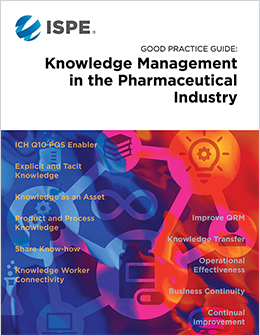Webinar: Knowledge Management Insights and More

On 26 January 2022, representatives of the author team for the ISPE Good Practice Guide: Knowledge Management in the Pharmaceutical Industry held a webinar to provide an overview of the guide, which published in May 2021. Over 300 attendees joined the authors as they discussed key concepts of knowledge management (KM), linkages to current regulatory guidance, KM methods and tools, and relationships with complementary disciplines. Throughout the webinar, the authors polled the audience on topics around participants’ current understanding of KM, the current state of KM initiatives in the participants’ organizations, and what other processes the audience felt could benefit from additional KM focus and application.
 In 2018, the ISPE KM Good Practice Guide (GPG) team started their partnership with the Product Quality Lifecycle Implementation (PQLI®) Steering Committee. In 2019, they received approval from ISPE to officially form a team and began authoring the content in 2020. After addressing industry comments, the guide was published in May 2021, and the author team plans to continue to partner with ISPE through webinars, blogs, and potential future opportunities for training.
In 2018, the ISPE KM Good Practice Guide (GPG) team started their partnership with the Product Quality Lifecycle Implementation (PQLI®) Steering Committee. In 2019, they received approval from ISPE to officially form a team and began authoring the content in 2020. After addressing industry comments, the guide was published in May 2021, and the author team plans to continue to partner with ISPE through webinars, blogs, and potential future opportunities for training.
One of the main drivers for the KM good practice guide (GPG) team was to establish a foundational understanding of KM and how KM concepts apply specifically to the pharmaceutical industry. Although KM was first discussed in International Council for Harmonisation of Technical Requirements for Pharmaceuticals for Human Use (ICH) Q10 in 2008 and again in ICH Q12 in 2020, only 11% of the webinar’s audience members stated that KM efforts were well in progress within their organizations, and 41% were still investigating KM but hadn’t started yet. The webinar polling results demonstrate the value and need for fundamental and practical knowledge in this space.
KM and the Pharmaceutical Industry
Although KM and quality risk management (QRM) are both identified as enablers of an effective product quality system (PQS), the definitions of KM and KM for pharmaceutical manufacturing have remained unclear. Polling during the webinar showed that only 33% of the audience felt confident they had a good understanding of what KM is, with 28% acknowledging they did not have a good understanding, and with the remaining 39% unsure of their level of understanding. The webinar expanded on the definition of KM per ICH Q10 by providing an additional definition commonly used by KM practitioners across industries that embraces the needs of the knowledge user as well as managing knowledge for the business benefit:
The application of a structured process to help information and knowledge flow to the right people at the right time so they can act more efficiently and effectively to find, understand, share, and use knowledge to create value.1
The team also expanded on the term “knowledge” with two concepts:
- Types of knowledge: Explicit, which includes knowledge that is written down, and tacit, which is the knowledge that remains in our heads. Tacit knowledge accounts for the majority of our overall knowledge, but can be difficult to transfer (e.g., decision rationales), and benefits greatly from KM methods and tools to identify and retain.
- Data, information, knowledge, and wisdom (DIKW) diagram, in which the team discussed the distinctions between these descriptions and noted it is important to understand that data and knowledge are not synonyms.
The webinar provided additional insights into the content of the GPG, highlighting the guide’s deeper dives into topics, including KM and the pharmaceutical quality system; a framework for linking KM to risk management; a KM process model; the pharmaceutical product knowledge life cycle; and general Principles & Common Approaches for Digital KM. More than two-thirds of the guide’s content contains appendices with practical details on how to get started with KM; measuring maturity, methods, and tools; common templates; and pharmaceutical-specific case studies to expand the industry's foundational understanding and application of KM.
Methods and Tools
The webinar expanded into more details on KM Methods & Tools discussed in the guide, which include description, value, use, and case studies for further study of Communities of Practice (CoPs); storage and search; lessons learned; knowledge mapping; and expertise location.
The authors also discussed the value of thinking of KM as another discipline within an organization’s capabilities. Complementary disciplines include QRM, organizational change management, operational excellence, content and information management, and learning and development. The webinar further explored the capabilities of operational excellence and knowledge management.
KM is an enabler for two aspects of the pharmaceutical industry: First, as an enabler to the PQS, and second as an enabler to operational excellence (OpEx). KM and OpEx share synergistic goals and concepts, as both disciplines:
- Achieve efficiency and optimization
- Enable organizational objectives
- Share a focus on flow
- Look to enable and engage the workforce
- Utilize standard approaches and tools built into daily processes
Where OpEx looks to optimize product and process flow, KM seeks to optimize organizational knowledge flow. OpEx may leverage Lean and Six Sigma concepts to reduce waste and variation to support sustainable, efficient processes; KM leverages methods and tools to sustain knowledge and enable business continuity.
The authors highlighted that the guide explores this concept further in two aspects: The use of methods and tools to address waste and inefficiency in the flow of knowledge (e.g., search and surface of information, or faster, informed decisions); and business continuity in knowledge transitions (e.g., new molecular entities, mergers and acquisitions, commercialization, retirements, and transitions).
The audience was asked to identify their top three processes that could benefit from additional KM focus and/or application. These were the leading processes identified: continuous improvement, change management and post-approval changes, and technology transfer.
Questions and Answers
Audience engagement throughout the webinar was high, and multiple questions were submitted with the following themes:
- Measures for KM
- Navigating organizational change management
- The relationship between KM and training
- Roles and responsibilities
- Technology
| Question Theme | Insights from the KM GPG |
|---|---|
| Are there common measures for KM? |
Like many initiatives, the measures for KM are dependent on how an organization wants to deploy or leverage KM.
|
| What are the key organizational change management considerations for KM? |
The guide contains an appendix dedicated to developing an effective KM initiative, including considerations for organizational change management (OCM). The guide discusses fi ve key OCM recommendations:
|
| Can you expand on the relationship between KM and training? |
Training, or learning and development, is a complementary discipline to KM. Training utilizes content designed with adult learning theory to support employee skill development and qualification. This is a form of structured, formal knowledge transfer recognized by the KM discipline. However, by this design, training has a primary focus on the transfer of an organization’s explicit knowledge and remains focused on training content as a primary knowledge asset.
|
| What are the common roles and responsibilities for KM? |
The guide’s appendices outline common roles, descriptions, and responsibilities. What roles an organization utilizes may also be based on how the organization will utilize and deploy KM. Common examples include (but are not limited to):
|
| What role does technology/software play in KM in today’s digital era? |
Digitization is a prominent topic across the pharmaceutical industry; the guide has a chapter dedicated to the discussion of digitally enabled KM. A technology solution does not guarantee a successful KM initiative, and an organization can begin a KM initiative independent of a software solution. Technology should be viewed as an enhancement to a KM program, and the guide recognizes that digital solutions may make data, information, and knowledge easier to manage and find faster. If designed with KM in mind, these technologies can impact the speed at which an organization can make informed decisions. The guide further explores common digital approaches, technologies, and characteristics for digitally enabled KM. |
Table 1 provides responses to the questions that the authors could not cover during the webinar.




